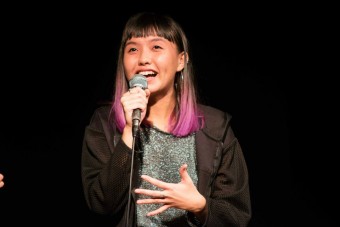Yum Chat panellist, Joyce Ho is an integral part of a tight-knit team who specialise in storytelling through motion design, having been with design-led motion studio Breeder since its inception in 2010. As Creative Lead, she prides herself on pushing the boundaries of motion and has an innate ability to apply that skill to the most challenging of projects – helping develop great ideas and bring them to life on the screen. Joyce is proud to be working with a group who share her design values and deep belief in the power of open collaboration and, with an awesome sense of humour, channels being a little bit different into a big point of difference for Breeder’s clients. Here she shares her work – Time of the Asian Century and talks with Eleanor Jackson, Editor in Chief.

Thank you for taking part in Yum Chat, I wonder if you have had any thoughts from the event that stayed with you? How much commonality/difference did you see with the other presenters?
Yum Chat was great to be part of, thank you for having me! One of the things that stayed with me after the event was how each of us struggled with our Asian heritage to some degree and only fully accepted that part of ourselves once we figured out who we were. It was amazing to see that part of ourselves channelled in all our creative work differently!
You gave such a positive energy to the role that culture has played in your life/creative life at Yum Chat etc – and talked of “luck” and making your own luck too, in the career sense. Do you see that there are also “unlucky” migrants, i.e. those communities for whom political, cultural, social integration in Australia has not been so positive? How does this make you feel?
When my family migrated to Australia in 1992, the political landscape was very different to what it is today. My parents were granted permanent residency almost immediately as they’re teachers and we were Australian citizens within the year. In that sense, it’s definitely disappointing to see the criteria for immigration nowadays is far more strict, with many not being offered the support my family received back then. And it makes me angry when my fellow Aussies are not welcoming to those seeking asylum in our country. It should go without saying – migrants need our support and empathy to help change their lives for the better, as not everyone was lucky enough to be born in Australia.
You’re a motion designer by profession – only a few years ago “two screens” dominated film production – television and movie screens. Now there are computers, tablets, and phones and a multitude of other “screens” and their presence is increasingly ubiquitous. How does this change in technology open opportunities for the stories you can tell, commercially or creatively?
This change in technology has been amazing! My work can now reach a much wider audience, much more easily. The rise of online video has made motion design more accessible, commercially-sustainable and sought-after than ever before. And this will only increase in the coming years as online video begins to overtake film and television in viewership.
How are audiences changing with the increase in production values for commercially creative work?
With the increase of production values, audiences are becoming more and more savvy, and therefore more aware of what makes great work. Which is not a bad thing! It keeps all of us on our toes, it keeps us challenged and it keeps us motivated to produce high-quality work, as the bar gets raised higher and higher.
I love to hear about the technological and commercial constraints and realities – and the ways that this can generate great work. What ethics guide your production in a commercial sense?
Personally, I make sure I believe in each project I work on as that’s how I can guarantee I’ll do the best work possible. It must have a message or idea that I agree with. If it fails this criteria, I don’t take the project on. This thinking also applies to our client work at Breeder, each one of us has a say on whether we take on a project – we need to believe in it as a team.
Do you feel that commercial creatives have any responsibility to culture?
I don’t think commercial creatives declare a responsibility to culture, but we’re all aware of our ability to shape it. In my industry of film and motion, video content can be a very powerful medium as it has the ability to speak to people’s emotions and communicate messages quickly. And in our internet age, videos that have impact are easily shared with others, and it’s this power of reaching a lot of people that we can really influence and even help shape our culture.
Do you feel that being a creative person requires that you give back or tell a particular story or not do something else? Why or why not?
I can’t speak for all creatives, but personally, I have a strong drive to create work I’m proud of. Whether that means telling an emotionally-compelling story that connects with people, giving a voice to someone else’s idea or message that I wholeheartedly believe in, or creating aesthetically-beautiful visuals that leave people in awe – I want to do great work that I’m proud to share with the world.

